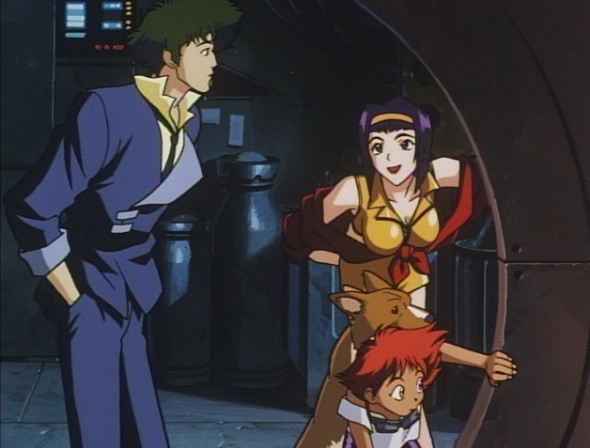
- The animal-as-a-hat motif is back! Yaay!
21) Boogie Woogie Feng Shui has a reputation as “the weird episode” of Cowboy Bebop, which considering that the show has already had episodes devoted to peyote freakouts and rampaging leftover seafood, is really saying something. It might be more accurate to call it the show’s most atypical episode. The plot revolves about a spirited teenager named Mei Fa, who’s on a quest for the Sunstone, a mystical object of power which may have the power to reunite her with her long lost (and presumed dead), father. This is actually a pretty standard plot in the grand scheme of things, but in the context of this show it feels peculiar indeed. Anyway, Jet was vaguely friends with Mei Fa’s father Pao back in the day, so he gets dragged along for the ride, leading to a couple of nifty chase scenes, some poorly explicated supernatural business about feng shui, a crucial last-minute use of the BeBop’s septic system (it vents into space, if you were curious), and lots of awkward jokes about how weird it is for a crusty old bounty hunter to be hanging around with a teenaged girl. (Pretty much all of Spike and Faye’s dialogue in the episode is devoted to mulling this over. “Is she his secret girlfriend?” “Mmm… too young. Maybe an estranged lovechild?” “Mmm… too old.”)
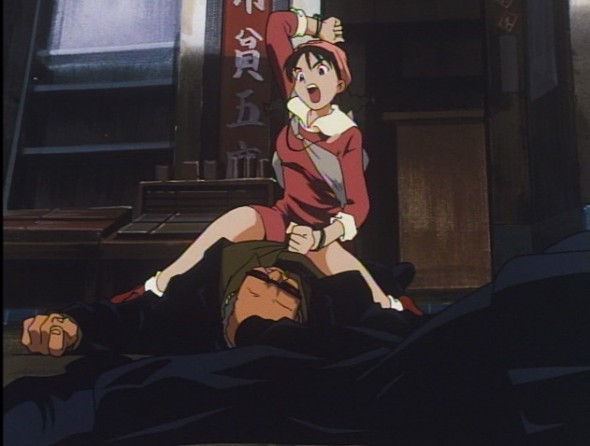
- Mei Fa, shown here being particularly spirited.
Cowboy Bebop is a show that tends to reward an intertextual approach on the part of the audience. Trying to experience it as a self-contained system, New Criticism style, does not get you very far. But there are drawbacks to reading for the allusions, too. The first big drawback is that you’re not going to catch all of them. Take Mei-Fa’s orrery-ey fortune telling device, the luopan. I assumed that was just a traditional fortune telling device, and I’m guessing a lot of the American audience did too. Someone who has some sense of how Feng Shui works, on the other hand, is going to understand that this is a crazy sci-fi fortune telling device, because traditional luopans (and even most untraditional ones) are flat.
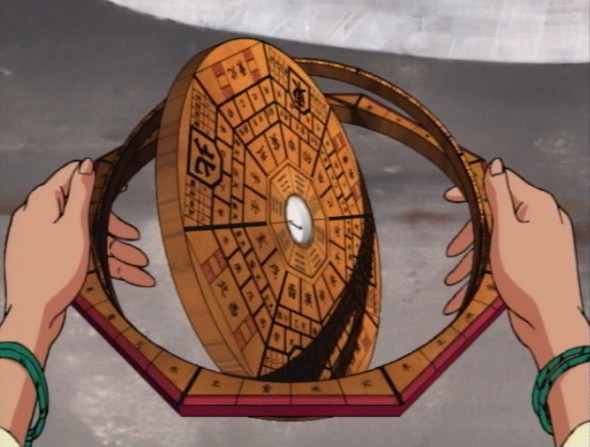
- That ain’t normal.
Someone who knows a little feng shui will react to this image more or less the way that I reacted to the 3D chess sets in Star Trek: by saying “man, stuff in the future is totally off the hook!” Similarly, the scene where they find the sun stone “where the four gods meet” is completely surreal to your average White Anglo-Saxon Protestant, whereas I’m assuming that at least some of the Japanese audience understood what was going on.
Here, I’ll recap the scene for you: they’re walking in a random public plaza, when Mei Fa suddenly stops and points off into the cardinal directions, shouting excitedly,
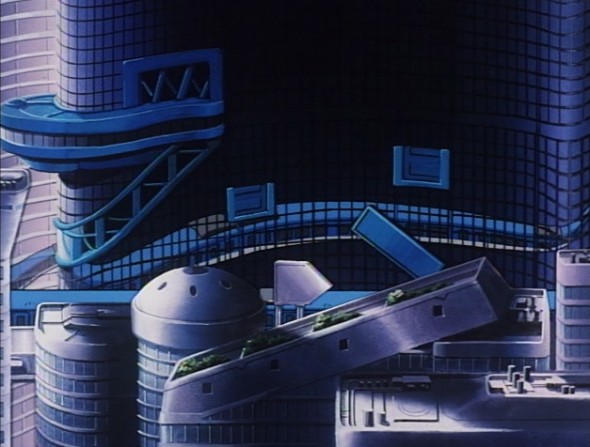
- “Blue Serpent!”
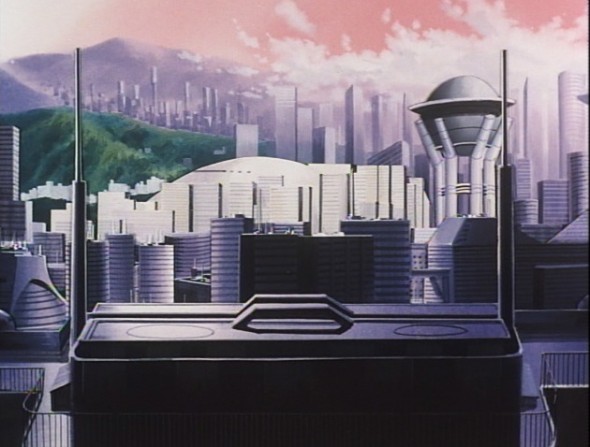
- “White Tiger!” (It took me forever to see anything other than buildings on this one – it’s supposed to be in profile, with the head on the left. Squint. It helps.)
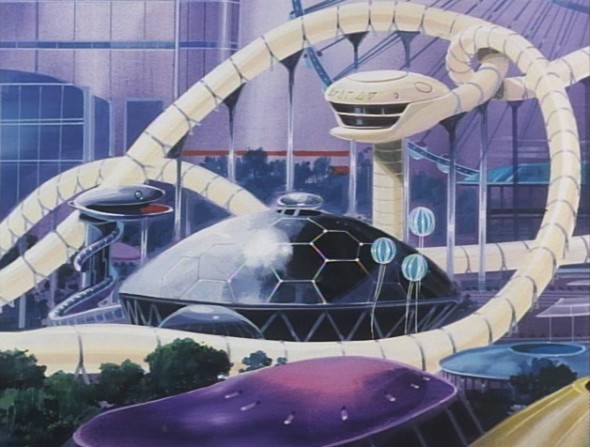
- “Black Turtle!”
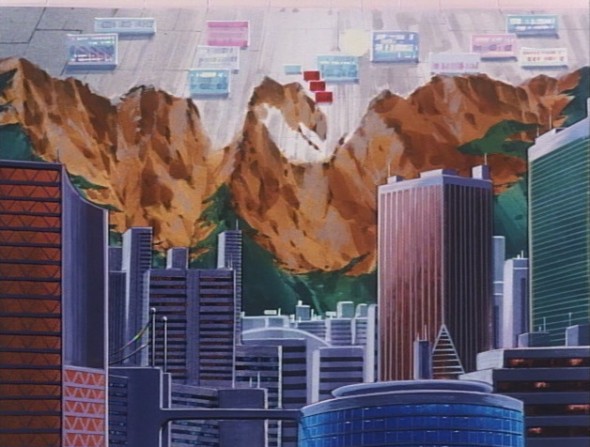
- “Red Pheonix!”
And from this, they deduce that the sunstone must be right where they’re standing, which it is. If you were hoping for more of an explanation, that’s really too bad. Because you aren’t getting one. For instance, you never learn whether her father put the stone there for her to find, or if he just used his feng shui magic to deduce where it was, or… well, anything about it, really. I’m sure if you do know a little of the lore behind it – or if you’re at least vaguely aware of the kind of thing that they’re referencing – this is still cool in a Dan Brownish way. But it threw me for kind of a loop. My fault, I know, not theirs – but still.
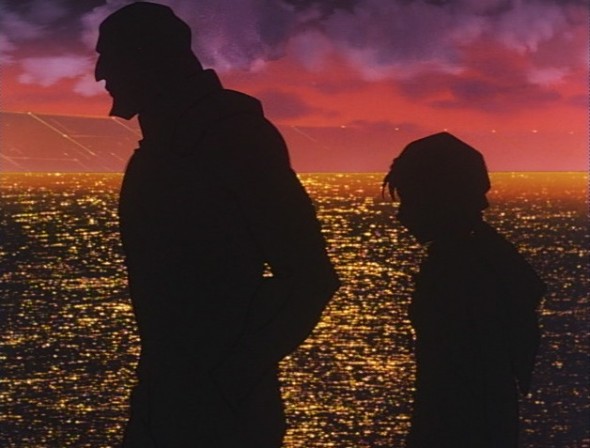
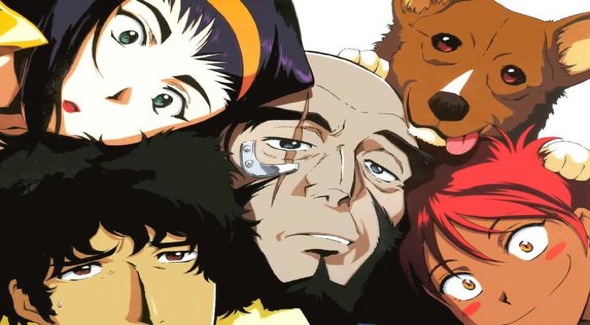
“By the way, this awesome orange color scheme is used nowhere else in the episode. In fact, the rest of it is pretty much blue, making it the extended version of that one obnoxious high-contrast color scheme they use in every single movie poster nowadays. Bebop did it before it was lame, though.”
I hope everyone is aware of this phenomenon. It’s quite striking. For an extensive gallery of examples:
http://www.slashfilm.com/2009/11/27/orangeblue-contrast-in-movie-posters/
Ah, I knew there was a gallery somewhere! I wanted to link to it but I couldn’t remember what website it was on. Thanks for that, Lee.
Although I’d call the trend more “damning” than “striking.” :-/
I can’t add anything here but I thought I would take out space and say that these articles are awesome.
Agreed. I love these articles and am really happy whenever a new one comes out.
8 pages?? F-yeah!
It’ll be a sad day when these are finished up and the series has been overthought. :D I hope you plan on doing the movie once the series is done!
One question I have about Spike’s “massive death wish.” It could be that, but I always figured Spike as a young guy to be an adrenaline junkie. He gets his thrills from dangerous situations. Unless that’s the same as a death wish. :D
I’ll probably do something about the movie… not sure quite what, though. I’ve been thinking a lot about how one could make Cowboy Bebop into a movie (because of the threatened live-action, all-Keanu-all-the-time remake), and I’m interested in how the show’s own creative team handled it. So one thought I had was to end my posts on the show itself with a list of dos and don’ts for a cinematic adaptation, and then watch the movie and see how it stacks up against that.
As for Spike’s death wish: I think at the beginning of the series, he comes off a lot more like an adrenaline junky (especially in the first episode, where he’s not interested in fighting Solensan until he realizes that the guy is nigh-indestructible), but that as the show goes on it seems more and more like he’s actually interested in finding his death, for a bunch of quasi-existential reasons. Before he goes off to fight Pierrot he actually says something like “Maybe this will finally be the one…” doesn’t he? He tries to play it off as a joke immediately afterwards, of course, but I don’t think we’re meant to believe him. I’ll go into this more in a future post, though. You bring up an interesting question.
MASSIVE SPOILER
*
*
*
*
*
*
*
*
*
*
The entire series is about death because, as we find out in the final series of episodes, Spike’s soul has basically been dead for years, and all that is left is for him to redeem his disgraceful life and die a Samurai’s death. Which of course he does.
Although, he’s marekd for death.
But, for real, the entire series is about redemption by chosing to die a good death.
In terms of Andy’s “death of cowboy identity”, what do you make of the end title reading “See You Space Samurai”? This might make the whole thing less a death than a transformation–Andy is still just as crazy, hokey and pseudo-cool as ever, he’s just swapped the superficial stereotype he’s imitating. (And even then, the cowboy stereotype arguably has a lot in common with the samurai one; you could argue that they’re similar archetypes.)
Anyway, awesome article!
I’ll see your “less a death than a transformation” and raise you a “what is death but a transformation?” When he hands Spike the hat and walks away, you’re supposed to think that his cowboy persona is dead (go ahead and put scare quotes around that if you want to). When he shows up as the samurai at the end, I find that it reads as a resurrection, or maybe a life-after-death, which amounts to pretty much the same thing.
The similarity of the cowboy and samurai archetypes is interesting, in that actual cowboys and actual samurai are about as different from each other as two groups of people have ever been. But in pop culture, they do seem to be functionally equivalent.